Because we spent the day exploring old Dubrovnik from one end to the other, I'm
going to insert a map of the old town at this point to make it easier to
understand our wanderings.
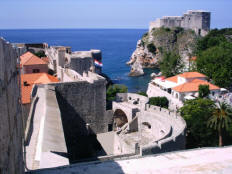
Lovrijenac Fortress from top of Pile Gate |
We walked the length of the Stradun toward the Pile Gate. (At one time, there were two settlements here,
one on the mainland, the other on an island. In the 13th century, the channel
between them was filled and became this wide street.) At the Pile Gate we
climbed the stairs to the top of the city walls, much to the boy's delight.
Running around on old city walls was always one of their favorite activities.
Going clockwise, we
walked and climbed all the way around the city, enjoying many fascinating and
diverse views.
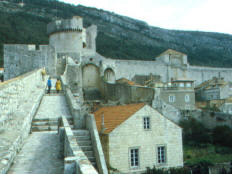
We approach Minceta, the largest tower |
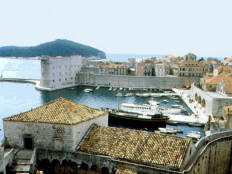
St. John Fortress across the harbor |

Looking back at harbor from St. John |
The main city wall is 1.6 miles long. It's up to 80 feet high
and varies in thickness from five to 20 feet. It has 17 towers (including
Minceta, the largest, on the northwest corner, and the casemate fortress Bokar
on the west), five bastions
(bulwarks), and a large fortress (St. John) on the south side of the harbor. The town was also defended from two
independent fortresses: Revelin on the north side of the harbor side, where we had entered the
city, and Lovrijenac across a channel from Bokar, near the Pile Gate.

View through an arch
|
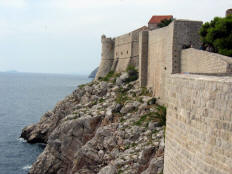
Southern walls
|

Lovrijenac & Bokar guard the
Pile Gate |
It took us more than an hour to walk around the walls, but it
was well worth it. We descended at the Pile Gate where we'd started. We spent
some time looking
around the square there, especially the Big Onofria Fountain, a very unusual
domed fountain (1438). There were orange trees growing there, too. We went
through the cloisters of the Franciscan Priory, where a pharmacy founded in 1319
is preserved and still functioning. The cloisters were beautiful and very
restful.
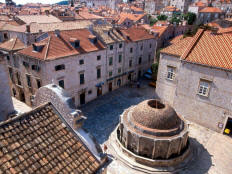
Big Onofria Fountain seen from wall |
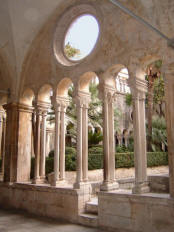
Franciscan Priory cloister |

Old pharmacy in Franciscan Priory |
We walked back to Luza Square and turned right, continuing past
the Town Hall (19th century) to the beautiful 15th century Rector's Palace. (The
Rector was the city's executive official, elected by the aristocracy.) It had an
especially lovely courtyard (atrium) with a graceful staircase. The building is
now a city museum.

Courtyard of Rector's Palace |

Rector's Palace |
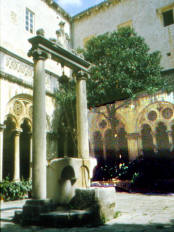
Well in Dominican Friary cloister |
On our way back to the car, we stopped to visit the Dominican
Friary with its restful 14th century cloister filled with orange
trees and a pretty well. About this time, I discovered that the film in
my Konica SLR camera had not been advancing since I'd last changed rolls. I fixed
it in a dark doorway of the Friary church, then ran back to try to recapture
some of the lost pictures. Unfortunately it was noon and the city walls were
just closing for two hours, so I couldn't go up to re-take the final couple of
shots from there.
We drove back to the hotel for lunch. Afterwards, the boys went
down to the beach below the hotel while Jane rested. I went back to the
old city to retake more of the lost pictures. By then the weather was warm and completely
sunny. I went halfway around the city walls again and roamed all over the city.
It was almost deserted, in contrast to the moderate crowd we'd seen in the
morning, many of them young Americans seeing Europe on $2.00 a day.
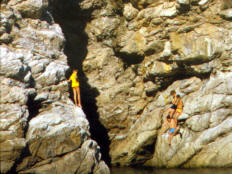
Our boys at the mouth of the cave |
I returned to the hotel to find Jane sunning herself on
the balcony and the boys still on the beach. Although they were wearing their
bathing suits, the water was still too cold for swimming. Nevertheless, they had
managed to catch four starfish in the mouth of the large cave in the cliff side.
Unfortunately, the starfish had shed various arms when caught and only one was
intact. (Kevin eventually threw that one back into the water.) When they finally
came up to the hotel, Larry had a bad chill from swimming the several yards
across the mouth of the cave. By the time we finished dinner, he was all right
again. The weather had turned quite cool by then.

Rector's palace by night |
After dinner, Jane and I went back to see the old city at
night. It was quite different than we expected. Instead of the floodlighting so
common in most of Western Europe's tourist cities, there were only small
lantern-style streetlights. While the result was less spectacular than it might
have been, it was much more natural. It made it easy to imagine yourself back in
medieval Dubrovnik.
On returning to the hotel, we inquired about what had happened
to the 1300-foot Ombla Falls we'd been unable to find. We learned that the river
had been diverted into an aqueduct several years earlier, but apparently the
authors of our guidebooks (Fodor and Baedeker) hadn't been informed.
Page 1
2
3
4
5
6
7
8
9
10
11
[public_html/Travels/borderbottom.htm]